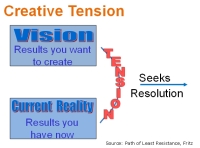[Guest blogger Nina Peterson, NCC, ACC is partner and COO at Wisdom Works. In her last blog, she addressed reflecting back to move forward.]
2011 is over two weeks old. How are you doing with your resolutions? Like so many other Americans, I determined to lose some weight by altering my diet and jumpstarting my exercise regimen. While I haven’t hit my goal, I’ve dropped enough pounds to wear smaller jeans—though they’re tighter than I’d like. I could have stuck with bigger, more comfortable jeans, but started to feel I was losing the momentum of my initial resolution. So you might say I’ve made my waistband a source of creative tension to help me toward my goal.
In the business world, we call resolutions “annual corporate goals” and they can follow a similar pattern to New Years’ resolutions. We’re all gung ho at first, following the implementation plan and excited about our initial progress. What happens next is nearly universal: as results progress, we begin to feel confident and relax. We start to cut corners, we get distracted by other priorities, and we stop focusing.
 In his book The Path of Least Resistance, Robert Fritz articulated the concept of creative tension. He explained that we establish creative tension once we have a clear picture of our current reality as well as a compelling vision of what we want. Because tension seeks resolution, the gap between the two is like a rubber band. The further our current reality is from our vision, the tighter the rubber band stretches. That tension can provide us energy to move toward our vision.
In his book The Path of Least Resistance, Robert Fritz articulated the concept of creative tension. He explained that we establish creative tension once we have a clear picture of our current reality as well as a compelling vision of what we want. Because tension seeks resolution, the gap between the two is like a rubber band. The further our current reality is from our vision, the tighter the rubber band stretches. That tension can provide us energy to move toward our vision.
As reality moves closer to our vision, the tension decreases, we become more comfortable, and our goals feel less urgent. So how can we maintain creative tension toward achieving our vision?
One answer is through discipline. That word may leave a bad taste in many of our mouths. We might think of military bootcamp, strict Catholic school experiences, or corporal punishment, but discipline can be a powerful form of support for maintaining creative tension. When applied properly, it becomes a key leadership quality—in both our work and our personal lives—that can help us toward fulfillment of our goals. Discipline might feel harsh at first, but in the long run it creates a groove that becomes easy to follow as we pursue our goals. Look at it this way: discipline can be far more than the denial of old behavior. We can transform it into a commitment to behaviors that will get us more of what we want in life.
Self-discipline requires we make our lives a more rigid container: one that surfaces our thoughts and our emotions, but does not necessarily act on all of them. It takes willpower to notice that we are wishing for an easy way out or that we are afraid of failing or looking foolish. And it takes courage to deliberately set aside these conflicting wishes and fears so that we may choose only actions that serve our vision.
As a leader, your ability to discipline your attention and stay committed to your organization’s goals will serve as a powerful model for others. When you stay connected to the metrics of your success, say the quantitative results your efforts are producing or the qualitative vitality of your workforce, then you can acknowledge and reward progress. But don’t stop there! It’s critical that you continue to make a compelling case for the bigger vision, bringing new motivations to light and creating fresh energy for the collective effort.
For me, when my pants felt loose, it was time to switch to a smaller pair. Forget “relaxed fit” jeans: I want my creative tension high enough to reach my goal. Take it from me: this constant re-tensioning of my vision is a belt-tightening strategy that really works!
Photo by leosaumurejr





